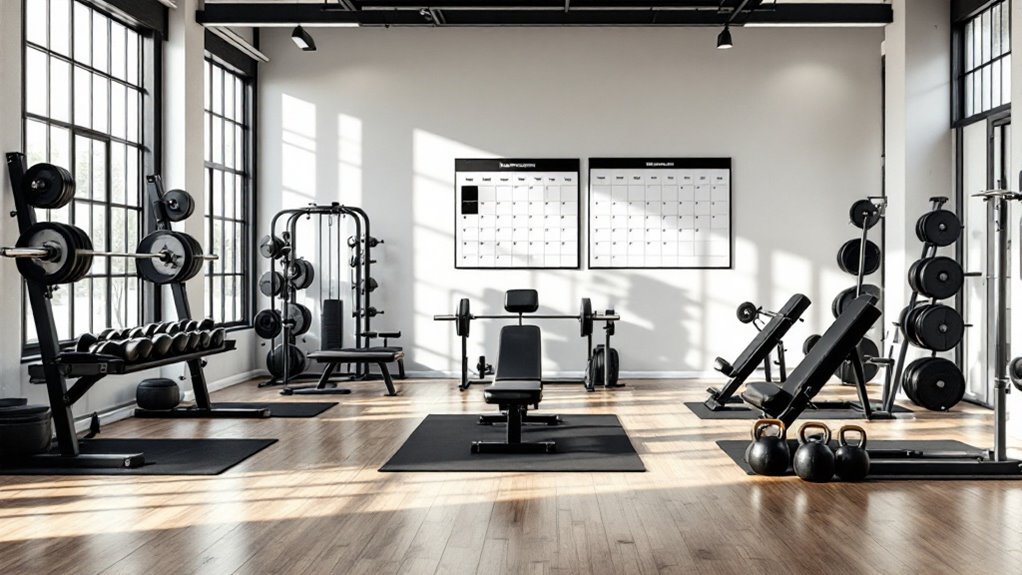Weekly Gym Routine for Men

A well-structured weekly gym routine for men follows a split training approach targeting different muscle groups each day. The program typically includes chest/triceps, back/biceps, and legs/shoulders with 48-72 hours rest between working the same muscles. Essential exercises like bench press, pull-ups, squats, and deadlifts form the foundation, while tracking progress guarantees continuous improvement. Proper rest, nutrition, and progressive overload principles release the full potential of this strategic training approach.
Key Takeaways
- Split workouts into chest/triceps, back/biceps, legs/shoulders, with rest days between to optimize muscle recovery and growth.
- Perform compound exercises like bench press, squats, and deadlifts as the foundation of each workout session.
- Train each muscle group 1-2 times per week, allowing 48-72 hours of rest between sessions targeting the same muscles.
- Follow progressive overload by gradually increasing weights, reps, or sets to continually challenge muscles and prevent plateaus.
- Track workout performance, body measurements, and recovery metrics weekly to ensure consistent progress and make necessary adjustments.
Understanding the Basics of a Split Training Program

A well-structured split training program serves as the foundation for any successful fitness journey.
Split training divides workouts by muscle groups across different days, allowing adequate recovery while maintaining consistent training frequency. This systematic approach prevents overtraining and optimizes muscle growth potential.
A typical split might include chest and triceps on Monday, back and biceps on Wednesday, and legs and shoulders on Friday. This arrangement guarantees each muscle group receives focused attention and 48-72 hours of recovery time.
For beginners, this structure creates a clear roadmap while teaching proper exercise sequencing and recovery principles that build lasting results.
While this is one approach, full body workouts can be more beneficial for newcomers to strength training who need to develop overall fitness fundamentals.
Essential Exercises for Each Muscle Group

Building muscle requires mastering fundamental movements that target specific muscle groups effectively.
Success in bodybuilding starts with perfecting basic exercises that efficiently work each major muscle group in your training program.
For chest development, the bench press and dumbbell flyes reign supreme.
Back muscles respond well to pull-ups, bent-over rows, and lat pulldowns.
Shoulder gains come from overhead presses and lateral raises.
The squat and deadlift are non-negotiable for leg strength, while lunges target stabilizing muscles.
For arms, incorporate tricep pushdowns and bicep curls.
Core work should include planks and cable rotations.
These compound and isolation exercises create a thorough foundation for muscle growth when performed with proper form and progressive overload.
Following a split routine program allows dedicated focus on specific muscle groups while ensuring adequate recovery between workouts.
Rest and Recovery Strategies

Rest periods between workouts prove just as vital as the training sessions themselves for achieving ideal muscle growth and strength gains.
Quality sleep, proper nutrition, and active recovery techniques form the foundation of effective recovery.
Muscular repair requires 48-72 hours between training the same muscle groups. During this time, athletes should focus on foam rolling, gentle stretching, and low-intensity activities like walking.
Sleep optimization means targeting 7-9 hours nightly in a cool, dark room.
Post-workout nutrition timing matters – consuming protein and carbohydrates within 30 minutes after training accelerates recovery.
Hydration remains essential, with men needing roughly one gallon of water daily.
Following progressive overload principles helps prevent plateaus while maintaining proper recovery protocols.
Tracking Progress and Adjusting Your Routine

Tracking measurable progress stands as the cornerstone of any successful fitness journey. Men should document key metrics weekly and evaluate their routine's effectiveness monthly to guarantee continuous improvement.
| Metric Type | What to Track | Frequency |
|---|---|---|
| Performance | Weight lifted | Each session |
| Body Comp | Weight/BF% | Weekly |
| Recovery | Sleep/Soreness | Daily |
Strategic adjustments to routines should be based on data-driven insights. When progress plateaus, modifications to volume, intensity, or exercise selection become necessary. This systematic approach to tracking and adjusting guarantees long-term success and prevents stagnation in training results. Following compound exercise movements is essential for beginners to establish proper form and maximize muscle growth potential.
Frequently Asked Questions
Should I Take Pre-Workout Supplements Before Going to the Gym?
Pre-workout supplements can improve gym performance through ingredients like caffeine, beta-alanine, and creatine, boosting energy and focus.
However, they're not essential for results. Starting with natural alternatives like black coffee or a banana is recommended.
If choosing supplements, research ingredients carefully, start with half-doses to assess tolerance, and avoid taking them late in the day to prevent sleep disruption.
What Should I Eat Immediately Before and After My Workout?
Pre-workout nutrition should include easily digestible carbs and protein 1-2 hours before exercise – like a banana with peanut butter or oatmeal with protein powder.
Post-workout, consume protein and carbs within 30 minutes to optimize recovery and muscle growth.
An ideal post-workout meal combines lean protein (chicken, fish, or whey) with complex carbs (sweet potato, rice, or quinoa) and moderate healthy fats.
Is It Better to Work Out in the Morning or Evening?
While science shows both morning and evening workouts can be effective, each timeframe offers distinct advantages.
Morning sessions boost metabolism, improve mental focus, and help establish consistent routines.
Evening workouts benefit from higher body temperature, increased strength potential, and better muscle function.
The best time essentially depends on individual schedules, energy patterns, and long-term consistency – choose what works reliably with daily responsibilities.
How Long Should I Wait Between Sets During Weight Training?
Rest intervals between sets typically range from 30 seconds to 3 minutes, depending on training goals.
For muscle growth, 1-2 minutes is ideal, allowing sufficient recovery while maintaining muscle tension.
Power and strength training requires 2-3 minutes for full ATP replenishment.
Circuit training uses shorter 30-second breaks to maintain increased heart rate.
Beginners should start with longer rest periods and adjust based on intensity.
Can I Do Cardio and Weight Training on the Same Day?
When it comes to combining cardio and weights, there's no need to put all your eggs in one basket.
It's perfectly acceptable and often beneficial to do both in the same session. The key is proper sequencing – perform weight training first when energy levels are highest, then follow with cardio.
This approach optimizes muscle gains while still reaping cardiovascular benefits. Just maintain proper hydration and nutrition throughout.
Final Thoughts
A well-structured gym routine can transform an ordinary man into a living, breathing force of nature. By understanding proper exercise splits, mastering fundamental movements, and allowing adequate recovery time, anyone can achieve their fitness goals. Regular progress tracking guarantees continuous improvement and helps adjust the routine as needed. With dedication and consistency, this weekly program serves as the blueprint for building the strongest version of oneself.


